Key takeaways:
- Vegan baking substitutes animal products with plant-based ingredients, allowing for creativity and experimentation in recipes.
- It promotes sustainability by reducing environmental footprints associated with traditional dairy and egg production.
- Key ingredients for vegan baking include alternatives like ripe bananas, applesauce, coconut oil, and alternative sweeteners such as maple syrup.
- Techniques like proper mixing, using the right leavening agents, and preheating ovens are crucial for successful vegan baking results.
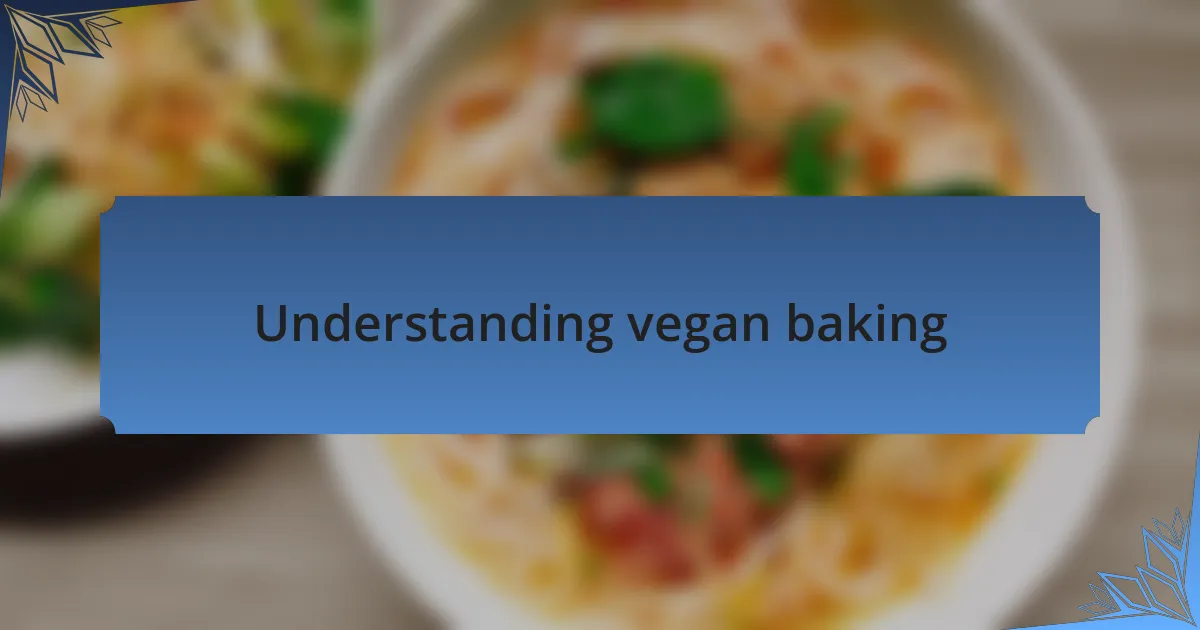
Understanding vegan baking
Vegan baking is fascinating because it challenges traditional recipes by substituting animal products with plant-based ingredients. I remember my first attempt at vegan cupcakes; I was skeptical about how they would turn out without eggs or dairy. The surprising result was a light, fluffy texture that won over even my non-vegan friends.
When diving into vegan baking, understanding the role of each ingredient is crucial. For instance, ripe bananas or applesauce can replace eggs to provide moisture and binding. This got me thinking: how many baking secrets have I missed by sticking to conventional recipes?
One of my favorite aspects of vegan baking is experimenting with alternative sweeteners like maple syrup or agave nectar. Initially, I found it challenging to balance flavors, but the process became an adventure. Have you ever tried using coconut flour instead of all-purpose flour? The texture might be different, but the results can be incredibly rewarding when you get it right.
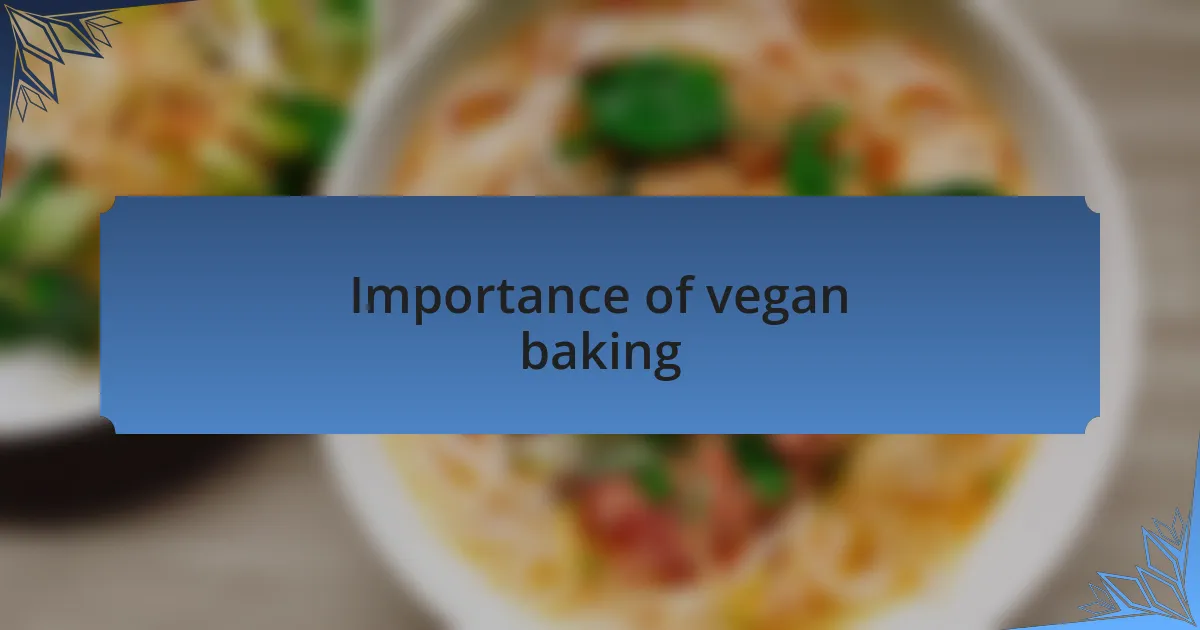
Importance of vegan baking
Vegan baking is important not just for health reasons, but also for sustainability. When I switched to this style of baking, I noticed a significant reduction in my environmental footprint. It made me reflect—how many resources are wasted in conventional dairy and egg production? Every vegan choice I make feels like a small but meaningful step toward a more sustainable lifestyle.
Moreover, vegan baking opens doors for creativity in the kitchen. I still remember the excitement I felt when I discovered how aquafaba—the liquid from a can of chickpeas—could be whipped into fluffy meringue. It sparked a new passion in me, encouraging experimentation that I never would have considered before. Have you ever thought about how ordinary ingredients can lead to extraordinary outcomes?
Vegan baking is also an inclusive option for those with dietary restrictions. Witnessing friends and family enjoy my vegan desserts brought me immense joy. It’s empowering to create treats that everyone can savor, regardless of their dietary choices. Don’t you think baking should be about sharing happiness with everyone?

Overview of American vegan desserts
American vegan desserts showcase a delightful fusion of traditional flavors and innovative ingredients. I recall the first time I tried a vegan apple pie, its fragrant cinnamon and nutmeg transported me back to my childhood family gatherings. Has there ever been a dessert that wrapped you in nostalgia? With ingredients like coconut cream and maple syrup, vegan versions can be equally indulgent, if not more so.
Pies and cakes are just the beginning; the world of vegan desserts in America is vast. From brownies made with black beans to banana bread that’s moist without any eggs, the creativity seems endless. My experimentation with these alternatives taught me that the texture and taste can be surprisingly satisfying. It’s a revelation to discover that you can enjoy a rich chocolate cake while still adhering to vegan principles.
Then there are the classic cookies, which have a unique charm in their vegan form. I remember the joy of baking a batch of oatmeal chocolate chip cookies, using flaxseed eggs as a substitute. When they came out of the oven, I felt a wave of pride knowing I had created something both delicious and compassionate. Have you explored the potential of vegan cookies in your baking adventures? You might be surprised by how much joy they can bring!
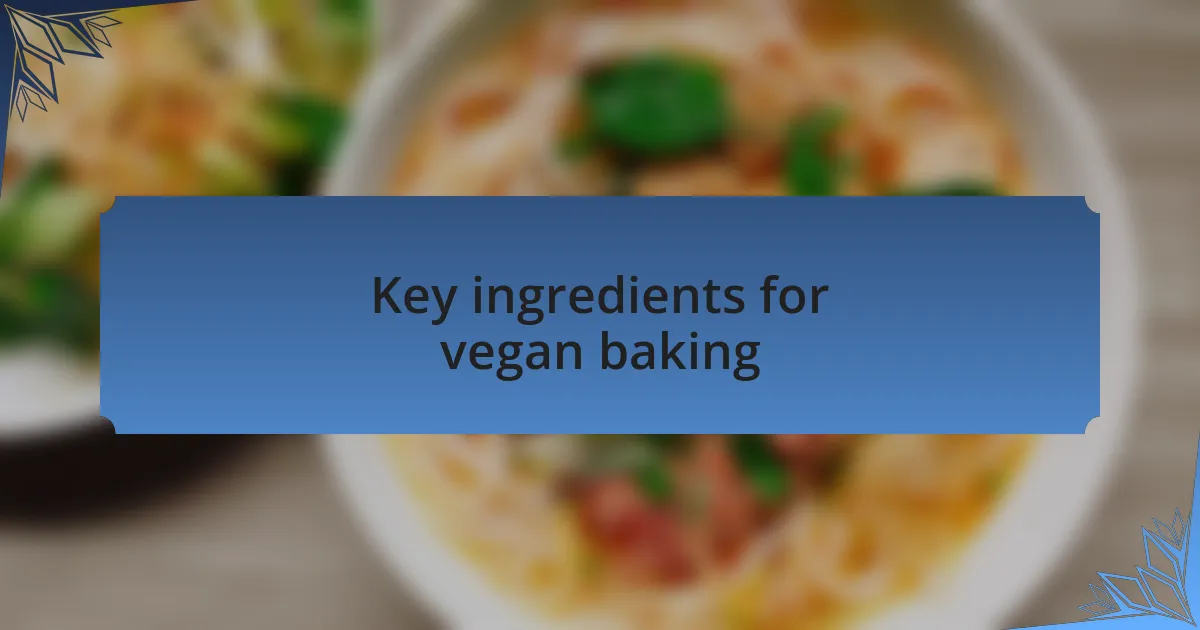
Key ingredients for vegan baking
When it comes to vegan baking, the staples often replace conventional ingredients with equally satisfying alternatives. For instance, instead of eggs, I often use applesauce or mashed bananas in my recipes. The first time I swapped in these ingredients for a cake, I was astounded by how moist and flavorful it turned out. Have you ever had a baked good that made you forget about the original ingredients entirely?
Another key component in vegan baking is finding the right fat. Coconut oil has become a favorite of mine; it adds a rich flavor and a tender crumb to cakes and cookies. I remember the first time I used it in a chocolate chip cookie recipe—it was like a warm hug in dessert form. The unique consistency can deepen flavors beautifully. Have you experimented with different oils in your baking?
Lastly, let’s not overlook sweeteners. While refined sugars are common, I love using maple syrup or agave nectar to give my treats a natural sweetness. One weekend, I decided to make a vegan carrot cake using maple syrup, and the result was spectacular; the deep amber color and rich taste were unforgettable. What sweeteners have you found to be game-changers in your baking escapades?
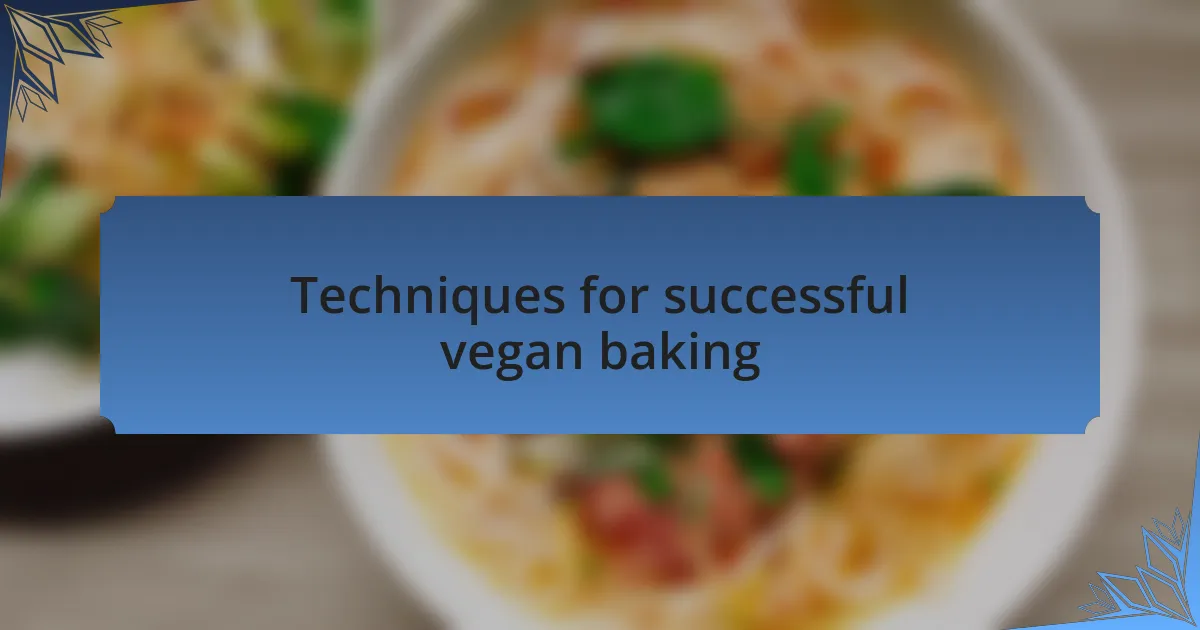
Techniques for successful vegan baking
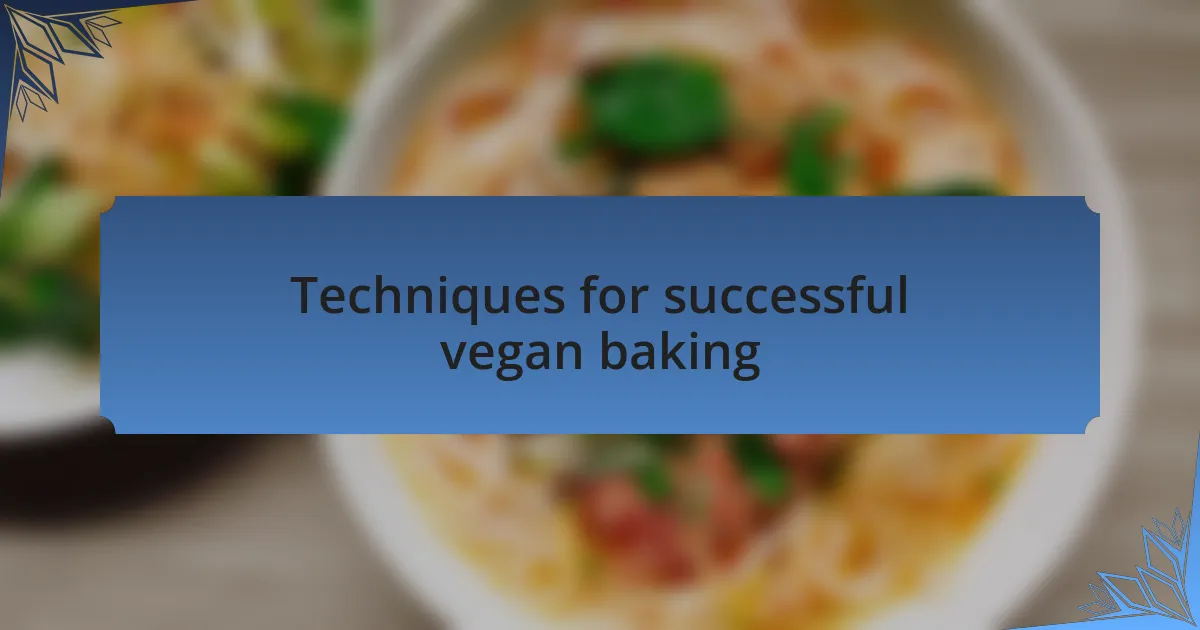
Techniques for successful vegan baking
One of the most crucial techniques I’ve learned in vegan baking is the importance of proper mixing. I used to just blend my ingredients until combined, but I discovered that mixing can make a significant difference in texture. For example, when I took the time to cream my coconut oil and sweetener together first, the cookies turned out fluffier and more delightful. Have you ever noticed how a bit of extra care in preparation changes the final product?
Another technique I embrace is making the most of leavening agents. Instead of eggs, using baking soda with an acidic ingredient like vinegar or lemon juice creates a wonderful rise in my cakes. I remember baking a vegan vanilla sponge for a friend’s birthday, and the light, airy texture blew everyone away. It made me wonder—what simple ingredient swaps have you tried that took your baking to new heights?
Lastly, I can’t stress enough the importance of preheating your oven and using the right bakeware. When I first plunged into vegan baking, I underestimated how this could impact my results. After a few flat and dense loaves, I learned that a properly heated oven and quality pans can be the difference between good and great. What baking mishaps taught you valuable lessons along your journey?
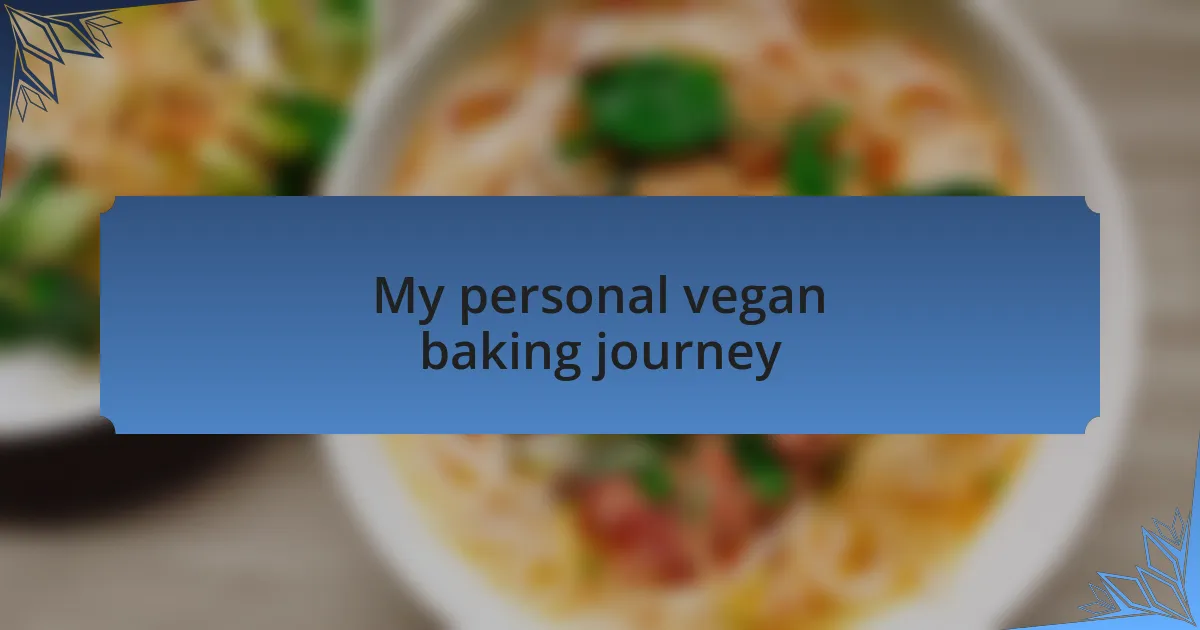
My personal vegan baking journey
My journey into vegan baking began with a simple desire to create healthier treats without sacrificing flavor. I remember the first time I made a vegan chocolate cake, substituting flaxseed meal for eggs. As I watched the mixture come together, I felt a mix of excitement and trepidation. Would it taste good? To my surprise, it turned out rich and moist, leaving my non-vegan friends raving about it. Isn’t it amazing how a little creativity can transform how we think about dessert?
One challenge I faced was learning how to find the right substitutes for dairy. Initially, I tried almond milk in my recipes, but I soon realized that coconut milk added a luscious creaminess that worked wonders in my pastries. I made a batch of vegan lemon bars, and the rich filling paired with the crumbly crust turned out to be a surprising hit at a family gathering. Have you ever changed one ingredient and felt like you unlocked a secret in your cooking?
Over time, I’ve embraced the idea that baking is not just about following a recipe, but also about experimenting and having fun. One of my proudest moments was creating a decadent vegan cheesecake, using cashews soaked overnight as the base. The joy on my friends’ faces when they indulged in it made me realize how rewarding vegan baking could be. How does cooking bring you joy and connection? It certainly has become a meaningful part of my life.
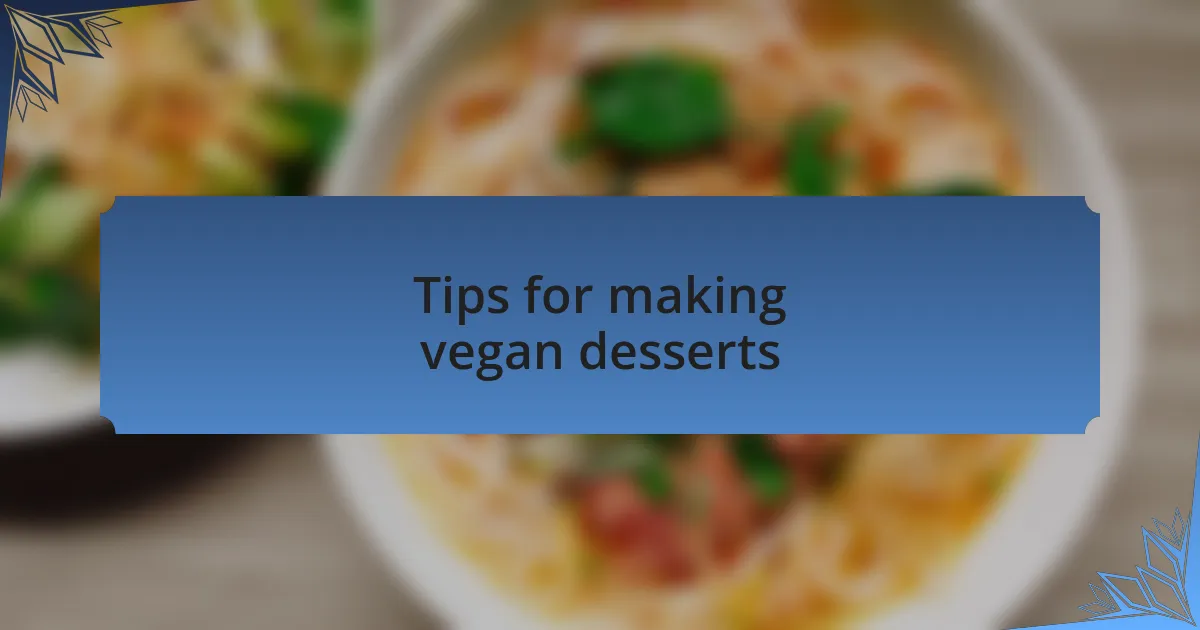
Tips for making vegan desserts
When it comes to making vegan desserts, I find that flavor and texture are paramount. A great tip is to play with sweeteners; for instance, I’ve had success replacing refined sugar with maple syrup or agave nectar. This not only adds a unique flavor profile but also keeps the desserts moist, which is essential for cakes and brownies. Have you ever noticed how the right sweetener can elevate a dessert’s overall taste?
Substituting traditional ingredients can be daunting, but experimenting can lead to delightful surprises. Once, I made a batch of chocolate chip cookies using aquafaba—the liquid from chickpeas—instead of eggs. The result was a chewy, airy cookie that impressed even my toughest critics. It taught me that embracing unconventional ingredients can unlock new culinary experiences. What’s the most unexpected ingredient you’ve used in your baking?
I also highly recommend using quality dairy alternatives, particularly for creams and butters. I once tried a dairy-free butter in a pie crust, and it made the crust flaky and delicious, just as if I had used the real thing. It’s moments like these that affirm how rewarding vegan baking can be. Don’t you love discovering a simple swap that makes a big difference in your baking adventures?